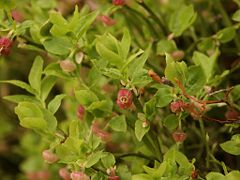Bilberry
| Bilberry | ||||||||||||||
|---|---|---|---|---|---|---|---|---|---|---|---|---|---|---|
 Bilberry in flower
|
||||||||||||||
| Scientific classification | ||||||||||||||
|
||||||||||||||
| Binomial name | ||||||||||||||
| Vaccinium myrtillus L. |
Bilberry is a name given to several species of low-growing shrubs in the genus Vaccinium (family Ericaceae) that bears fruits. The species most often referred to is Vaccinium myrtillus L., primarily known as the European blueberry. Other names are blaeberry, whortleberry, whinberry (or winberry),wimberry, myrtle blueberry, fraughan, and other names regionally. They were called black-hearts in 19th century southern England, according to Thomas Hardy's 1878 novel, The Return of the Native, (pg. 311, Oxford World's Classics edition). In Germany and Austria, Bilberrys are referred to as "blueberrys", whereas the garden blueberry is called "Heidelbeere".
Contents |
Nomenclature extended

The word bilberry is also used at times in the common names of other species of the genus, including:
- Vaccinium uliginosum L. (bog bilberry, bog blueberry, bog whortleberry, bog huckleberry, northern bilberry)
- Vaccinium caespitosum Michx. (dwarf bilberry)
- Vaccinium deliciosum Piper (Cascade bilberry)
- Vaccinium membranaceum (mountain bilberry, black mountain huckleberry, black huckleberry, twin-leaved huckleberry)
- Vaccinium ovalifolium (oval-leafed blueberry, oval-leaved bilberry, mountain blueberry, high-bush blueberry).
Wild and cultivated harvesting
Bilberries are found in damp, acidic soils throughout the temperate and subarctic regions of the world. They are closely related to North American wild and cultivated blueberries and huckleberries in the genus Vaccinium. The easiest way to distinguish the bilberry is that it produces single or paired berries on the bush instead of clusters, as the blueberry does.
The fruit is smaller than that of the blueberry, and similar, yet far superior in taste. Bilberrys are darker in colour, and usually appear near black with a slight shade of blue. While the blueberry's fruit pulp is light green, bilberry is red or purple, heavily staining the fingers and lips of consumers eating the raw fruit. The red juice is used by european dentists to show children how to correctly brush their teeth, as any inproperly brushed areas will be heavily stained.
Bilberries are extremely difficult to grow and are thus seldom cultivated. They only grow in cold climates and near pine trees. Fruits are mostly collected from wild plants growing on publicly accessible lands, notably Fennoscandia, Scotland, Wales, Ireland, parts of England, Alpine countries, Poland, and northern parts of Russia. Note that in Fennoscandia, Austria, and Switzerland, it is an everyman's right to collect bilberries, irrespective of land ownership, with the exception of private gardens. Bilberries can be picked by a berry-picking rake like lingonberries, but are more susceptible to damage. Bilberrys are softer and more juicy than blueberrys, making them difficult to transport. Because of these factors, the bilberry is only available raw in gourmet stores, where they can cost up to 25 Euro per pound. Frozen bilberrys however are available all year round in most of Europe.
In Ireland, the fruit is known as fraughan, from the Irish fraochán, and is traditionally gathered on the last Sunday in July, known as Fraughan Sunday.
Bilberries were also collected at Lughnassadh in August, the first traditional harvest festival of the year, as celebrated by Gaelic people. The crop of bilberries was said to indicate how well the rest of the crops would fare in their harvests later in the year.
The fruits can be eaten fresh, but are more usually made into jams, fools, juices or pies. In France they are used as a base for liqueurs and are a popular flavoring for sorbets and other desserts. In Brittany, they are often used as a flavoring for crêpes, and in the Vosges and the Massif Central bilberry tart (tarte aux myrtilles) is a traditional dessert.
Bilberry is used as a food plant by the larvae of some Lepidoptera species - see list of Lepidoptera that feed on Vaccinium.
Possible medicinal uses
Often associated with improvement of night vision, bilberries are mentioned in a popular story of World War II RAF pilots consuming bilberry jam to sharpen vision for night missions. However, a recent study[1] by the U.S. Navy found no such effect and origins of the RAF story cannot be found.[2]
Laboratory studies have provided preliminary evidence that bilberry consumption may inhibit or reverse eye disorders such as macular degeneration,[3] but this therapeutic use remains unproven in humans.
As a deep blue fruit, bilberries contain dense levels of anthocyanin pigments linked experimentally to lowered risk for several diseases, such as those of the heart and cardiovascular system, eyes and cancer[4][5][6].
In folk medicine, bilberry leaves were used to treat gastrointestinal ailments, applied topically, or made into infusions. Such effects have not been scientifically proven.

See also
- List of fruits
- List of vegetables
References
- ↑ Muth ER, Laurent JM, Jasper P. The effect of bilberry nutritional supplementation on night visual acuity and contrast sensitivity. Altern Med Rev. 2000 Apr;5(2):164-73. Abstract.
- ↑ [1] Bilberry Bombs, WebMD, October 2000
- ↑ Fursova AZh, Gesarevich OG, Gonchar AM, Trofimova NA, Kolosova NG. Dietary supplementation with bilberry extract prevents macular degeneration and cataracts in senesce-accelerated OXYS rats. Adv Gerontol. 2005;16:76-9. (Article in Russian)Abstract.
- ↑ Bell DR, Gochenaur K. Direct vasoactive and vasoprotective properties of anthocyanin-rich extracts. J Appl Physiol. 2006 Apr;100(4):1164-70. Abstract.
- ↑ Chung HK, Choi SM, Ahn BO, Kwak HH, Kim JH, Kim WB. Efficacy of troxerutin on streptozotocin-induced rat model in the early stage of diabetic retinopathy. Arzneimittelforschung. 2005;55(10):573-80. Abstract.
- ↑ Roy S, Khanna S, Alessio HM, Vider J, Bagchi D, Bagchi M, Sen CK. Anti-angiogenic property of edible berries. Free Radic Res. 2002 Sep;36(9):1023-31.Abstract.